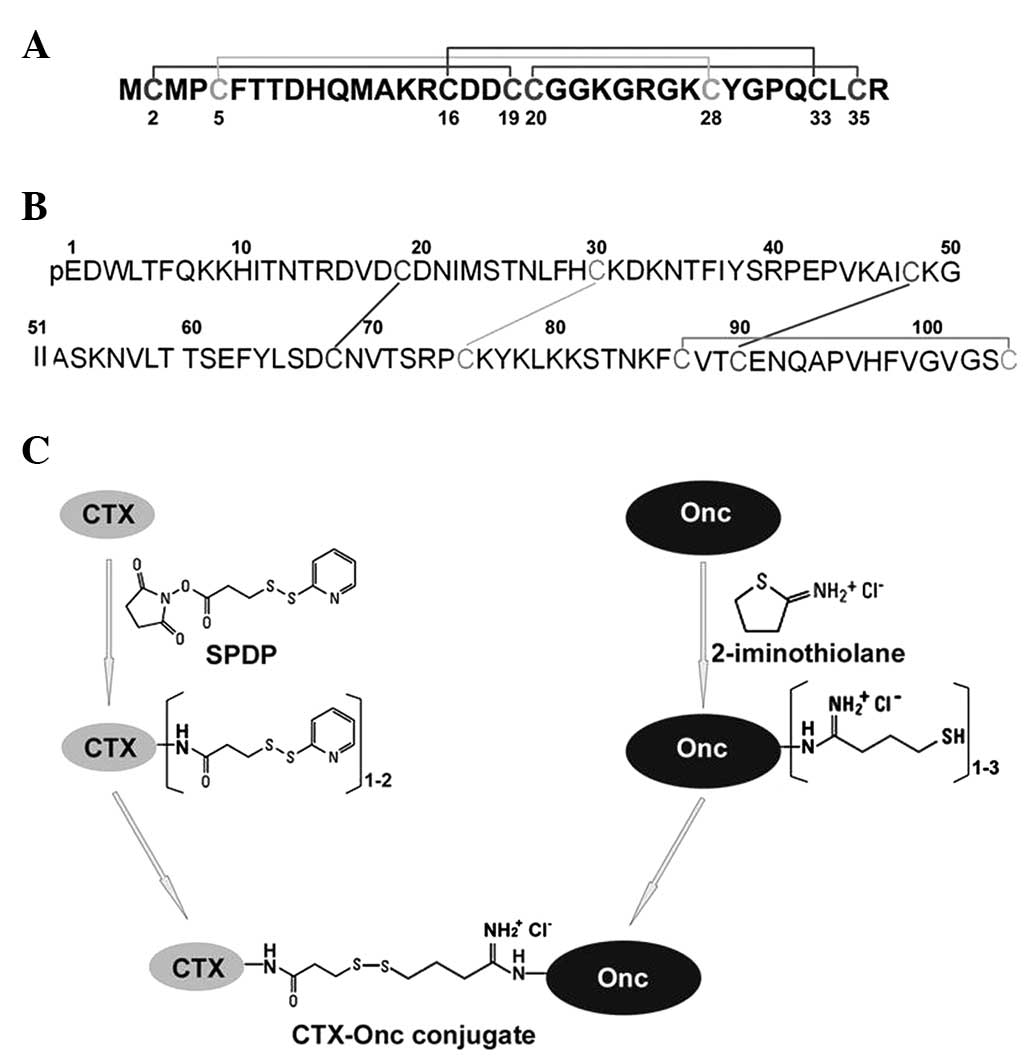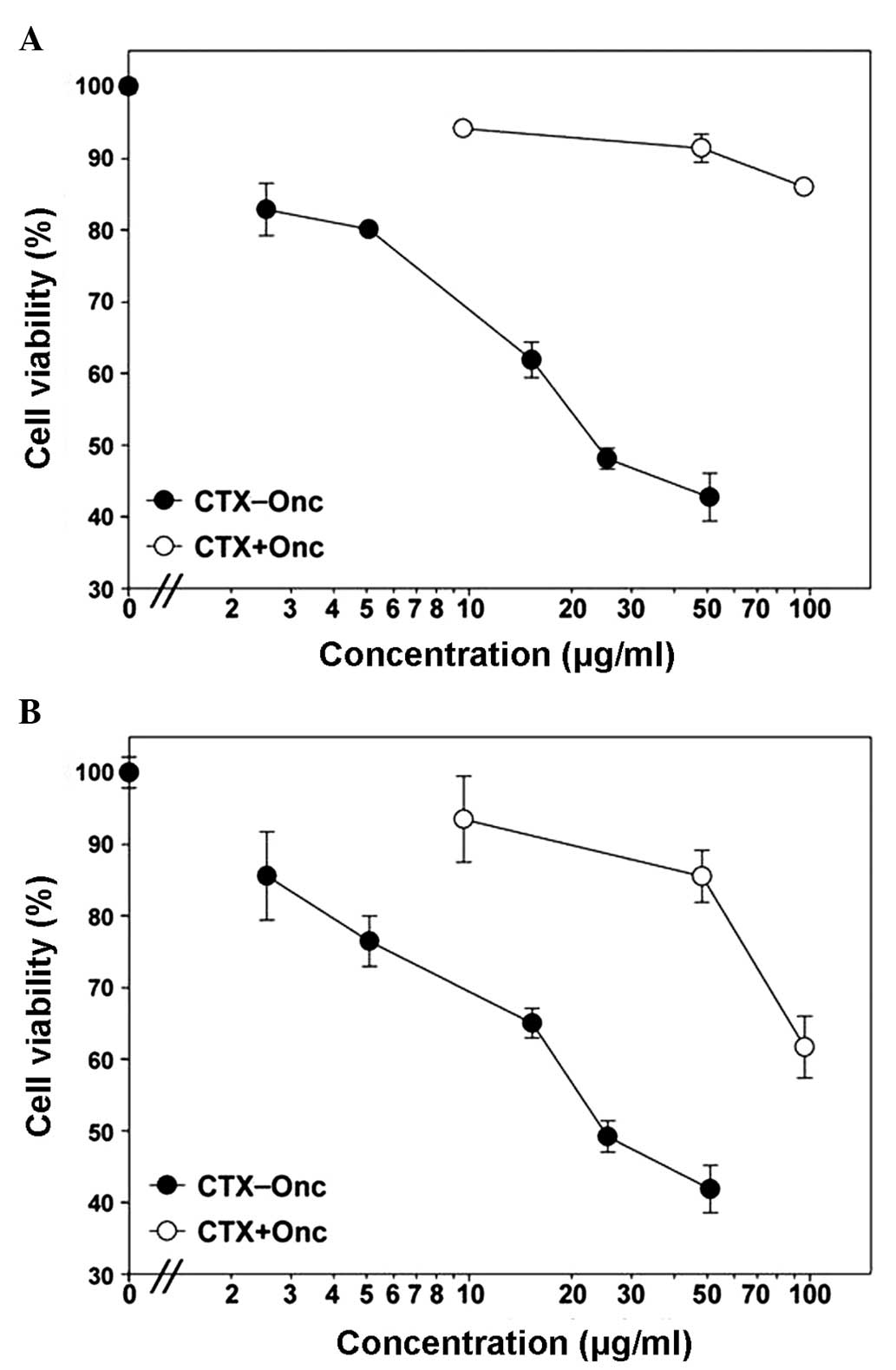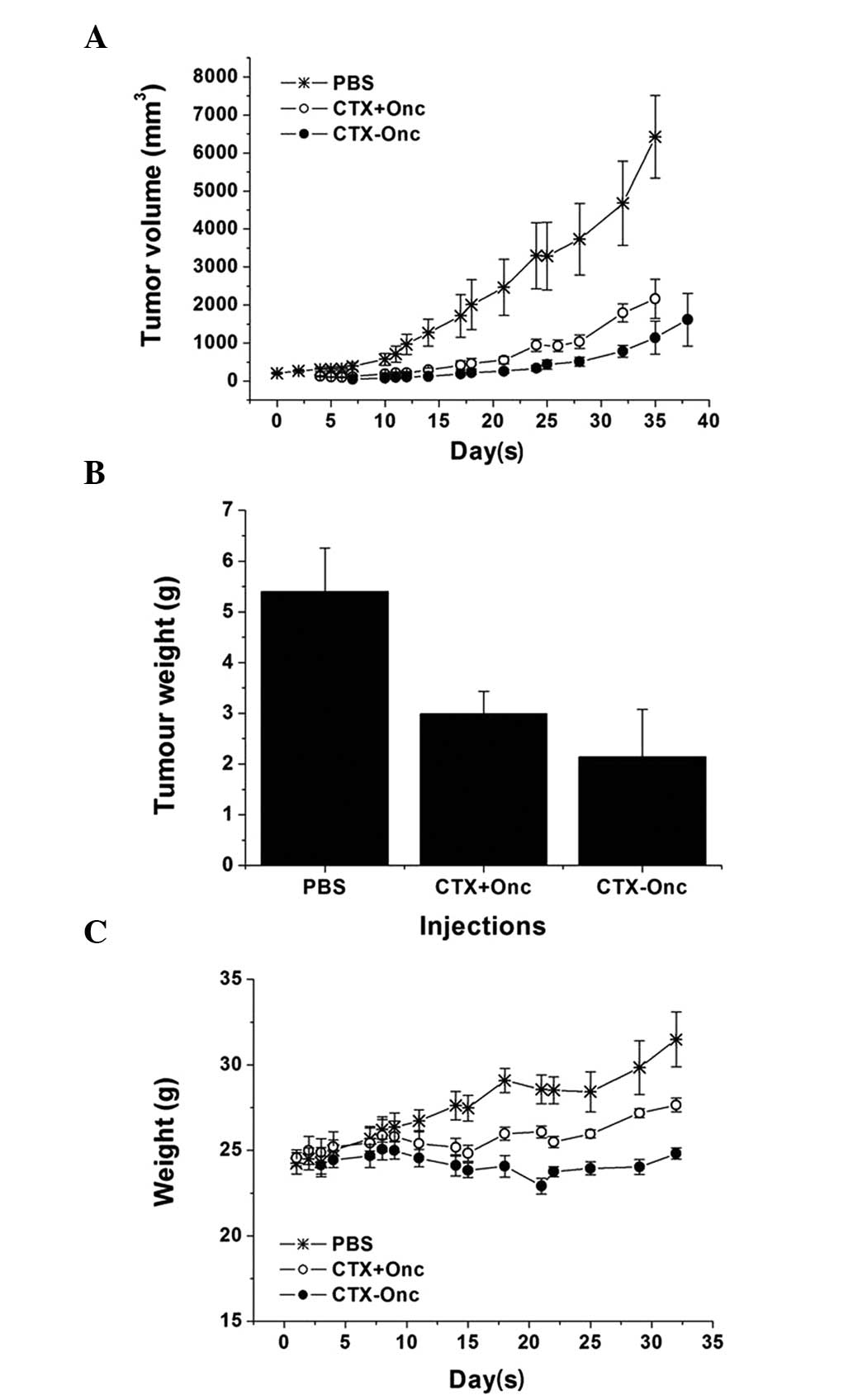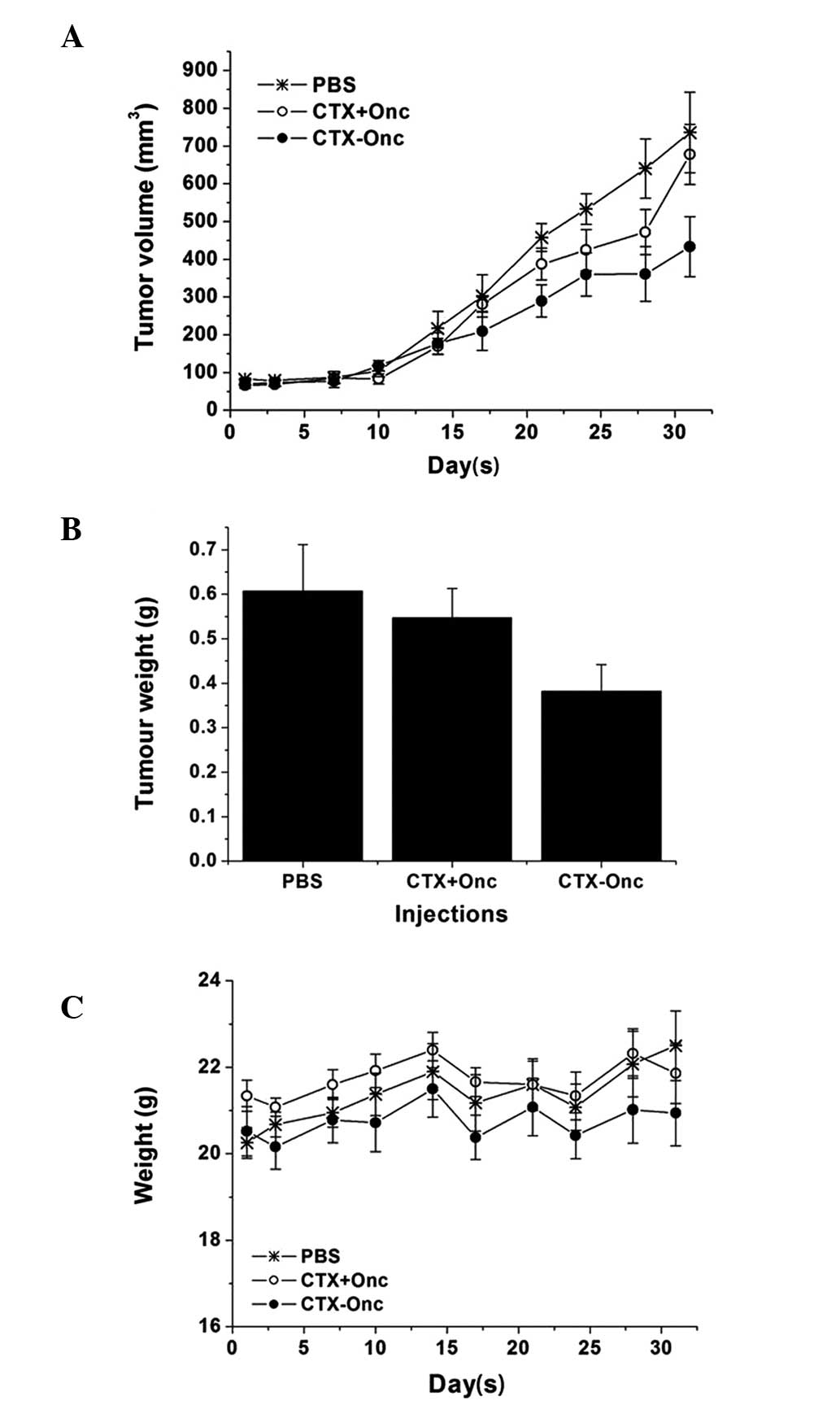|
1
|
Tanaka S, Louis DN, Curry WT, Batchelor TT
and Dietrich J: Diagnostic and therapeutic avenues for
glioblastoma: no longer a dead end? Nat Rev Clin Oncol. 10:14–26.
2013. View Article : Google Scholar
|
|
2
|
Watkins S and Sontheimer H: Unique biology
of gliomas: challenges and opportunities. Trends Neurosci.
35:546–556. 2012. View Article : Google Scholar : PubMed/NCBI
|
|
3
|
Lima FR, Kahn SA, Soletti RC, et al:
Glioblastoma: therapeutic challenges, what lies ahead. Biochim
Biophys Acta. 1826:338–349. 2012.PubMed/NCBI
|
|
4
|
Patel M, Vogelbaum MA, Barnett GH, et al:
Molecular targeted therapy in recurrent glioblastoma: current
challenges and future directions. Expert Opin Investig Drugs.
21:1247–1266. 2012. View Article : Google Scholar : PubMed/NCBI
|
|
5
|
Polivka J Jr, Polivka J, Rohan V, Topolcan
O and Ferda J: New molecularly targeted therapies for glioblastoma
multiforme. Anticancer Res. 32:2935–2946. 2012.PubMed/NCBI
|
|
6
|
Agarwal S, Sane R, Oberoi R, Ohlfest JR
and Elmquist WF: Delivery of molecularly targeted therapy to
malignant glioma, a disease of the whole brain. Expert Rev Mol Med.
13:e172011. View Article : Google Scholar : PubMed/NCBI
|
|
7
|
Soroceanu L, Gillespie Y, Khazaeli MB and
Sontheimer H: Use of chlorotoxin for targeting of primary brain
tumors. Cancer Res. 58:4871–4879. 1998.PubMed/NCBI
|
|
8
|
Lyons SA, O’Neal J and Sontheimer H:
Chlorotoxin, a scorpion-derived peptide, specifically binds to
gliomas and tumors of neuroectodermal origin. Glia. 39:162–173.
2002. View Article : Google Scholar : PubMed/NCBI
|
|
9
|
Deshane J, Garner CC and Sontheimer H:
Chlorotoxin inhibits glioma cell invasion via matrix
metalloproteinase-2. J Biol Chem. 278:4135–4144. 2003. View Article : Google Scholar
|
|
10
|
Kesavan K, Ratliff J, Johnson EW, et al:
Annexin A2 is a molecular target for TM601, a peptide with
tumor-targeting and anti-angiogenic effects. J Biol Chem.
285:4366–4374. 2010. View Article : Google Scholar :
|
|
11
|
DeBin JA, Maggio JE and Strichartz GR:
Purification and characterization of chlorotoxin, a chloride
channel ligand from the venom of the scorpion. Am J Physiol.
264:C361–C369. 1993.PubMed/NCBI
|
|
12
|
Veiseh M, Gabikian P, Bahrami SB, et al:
Tumor paint: a chlorotoxin: Cy5.5 bioconjugate for intraoperative
visualization of cancer foci. Cancer Res. 67:6882–6888. 2007.
View Article : Google Scholar : PubMed/NCBI
|
|
13
|
Sun C, Veiseh O, Gunn J, et al: In vivo
MRI detection of gliomas by chlorotoxin-conjugated
superparamagnetic nanoprobes. Small. 4:372–379. 2008. View Article : Google Scholar : PubMed/NCBI
|
|
14
|
Sun C, Fang C, Stephen Z, et al:
Tumor-targeted drug delivery and MRI contrast enhancement by
chlorotoxin-conjugated iron oxide nanoparticles. Nanomedicine
(Lond). 3:495–505. 2008. View Article : Google Scholar
|
|
15
|
Veiseh O, Kievit FM, Gunn JW, Ratner BD
and Zhang M: A ligand-mediated nanovector for targeted gene
delivery and transfection in cancer cells. Biomaterials.
30:649–657. 2009. View Article : Google Scholar :
|
|
16
|
Veiseh O, Gunn JW, Kievit FM, et al:
Inhibition of tumor-cell invasion with chlorotoxin-bound
superparamagnetic nanoparticles. Small. 5:256–264. 2009. View Article : Google Scholar :
|
|
17
|
Orndorff RL and Rosenthal SJ: Neurotoxin
quantum dot conjugates detect endogenous targets expressed in live
cancer cells. Nano Lett. 9:2589–2599. 2009. View Article : Google Scholar : PubMed/NCBI
|
|
18
|
Veiseh O, Sun C, Fang C, et al: Specific
targeting of brain tumors with an optical/magnetic resonance
imaging nanoprobe across the blood-brain barrier. Cancer Res.
69:6200–6207. 2009. View Article : Google Scholar : PubMed/NCBI
|
|
19
|
Kievit FM, Veiseh O, Fang C, et al:
Chlorotoxin labeled magnetic nanovectors for targeted gene delivery
to glioma. ACS Nano. 4:4587–4594. 2010. View Article : Google Scholar : PubMed/NCBI
|
|
20
|
Huang R, Han L, Li J, et al:
Chlorotoxin-modified macromolecular contrast agent for MRI tumor
diagnosis. Biomaterials. 32:5177–5186. 2011. View Article : Google Scholar : PubMed/NCBI
|
|
21
|
Fu Y, An N, Li K, Zheng Y and Liang A:
Chlorotoxin-conjugated nanoparticles as potential glioma-targeted
drugs. J Neurooncol. 107:457–462. 2012. View Article : Google Scholar
|
|
22
|
Cheng Y, Zhao J, Qiao W and Chen K: Recent
advances in diagnosis and treatment of gliomas using
chlorotoxin-based bioconjugates. Am J Nucl Med Mol Imaging.
4:385–405. 2014.PubMed/NCBI
|
|
23
|
Darzynkiewicz Z, Carter SP, Mikulski SM,
Ardelt WJ and Shogen K: Cytostatic and cytotoxic effects of Pannon
(P-30 Protein), a novel anticancer agent. Cell Tissue Kinet.
21:169–182. 1988.PubMed/NCBI
|
|
24
|
Ardelt W, Mikulski SM and Shogen K: Amino
acid sequence of an anti-tumor protein from Rana pipiens oocytes
and early embryos. Homology to pancreatic ribonucleases. J Biol
Chem. 266:245–251. 1991.PubMed/NCBI
|
|
25
|
Mosimann SC, Ardelt W and James MN:
Refined 1.7 A X-ray crystallographic structure of P-30 protein, an
amphibian ribonuclease with anti-tumor activity. J Mol Biol.
236:1141–1153. 1994. View Article : Google Scholar : PubMed/NCBI
|
|
26
|
Wu Y, Mikulski SM, Ardelt W, Rybak SM and
Youle RJ: A cytotoxic ribonuclease. Study of the mechanism of
onconase cytotoxicity. J Biol Chem. 268:10686–10693.
1993.PubMed/NCBI
|
|
27
|
Saxena SK, Sirdeshmukh R, Ardelt W, et al:
Entry into cells and selective degradation of tRNAs by a cytotoxic
member of the RNase A family. J Biol Chem. 277:15142–15146. 2002.
View Article : Google Scholar : PubMed/NCBI
|
|
28
|
Suhasini AN and Sirdeshmukh R: Transfer
RNA cleavages by onconase reveal unusual cleavage sites. J Biol
Chem. 281:12201–12209. 2006. View Article : Google Scholar : PubMed/NCBI
|
|
29
|
Rodríguez M, Torrent G, Bosch M, et al:
Intracellular pathway of Onconase that enables its delivery to the
cytosol. J Cell Sci. 120:1405–1411. 2007. View Article : Google Scholar : PubMed/NCBI
|
|
30
|
Newton DL, Hansen HJ, Mikulski SM, et al:
Potent and specific antitumor effects of an anti-CD22-targeted
cytotoxic ribonuclease: potential for the treatment of non-Hodgkin
lymphoma. Blood. 97:528–535. 2001. View Article : Google Scholar : PubMed/NCBI
|
|
31
|
Pavlakis N and Vogelzang NJ: Ranpirnase-an
antitumour ribonuclease: its potential role in malignant
mesothelioma. Expert Opin Biol Ther. 6:391–399. 2006. View Article : Google Scholar : PubMed/NCBI
|
|
32
|
Lee I, Kalota A, Gewirtz AM and Shogen K:
Antitumor efficacy of the cytotoxic RNase, ranpirnase, on A549
human lung cancer xenografts of nude mice. Anticancer Res.
27:299–307. 2007.PubMed/NCBI
|
|
33
|
Chang CH, Gupta P, Michel R, et al:
Ranpirnase (frog RNase) targeted with a humanized, internalizing,
anti-Trop-2 antibody has potent cytotoxicity against diverse
epithelial cancer cells. Mol Cancer Ther. 9:2276–2286. 2010.
View Article : Google Scholar : PubMed/NCBI
|
|
34
|
Wang XM, Luo X and Guo ZY: Recombinant
expression and downstream processing of the disulfide-rich
tumor-targeting peptide chlorotoxin. Exp Ther Med. 6:1049–1053.
2013.PubMed/NCBI
|
|
35
|
Wang XM and Guo ZY: Recombinant
expression, different downstream processing of the disulfide-rich
anti-tumor peptide Ranpirnase and its effect on the growth of human
glioma cell line SHG-44. Biomed Rep. 1:747–750. 2013.
|
|
36
|
Hockaday DC, Shen S, Fiveash J, et al:
Imaging glioma extent with 131I-TM-601. J Nucl Med. 46:580–586.
2005.PubMed/NCBI
|
|
37
|
Pavlakis N and Vogelzang NL: Ranpirnase-an
antitumor ribonuclease: its potential role in malignant
mesothelioma. Expert Opin Biol Therm. 6:391–399. 2006. View Article : Google Scholar
|
|
38
|
Xiang Y, Liang L, Wang X, et al: Chloride
channel-mediated brain glioma targeting of chlorotoxin-modified
doxorubicine-loaded liposomes. J Control Release. 152:402–410.
2011. View Article : Google Scholar : PubMed/NCBI
|














